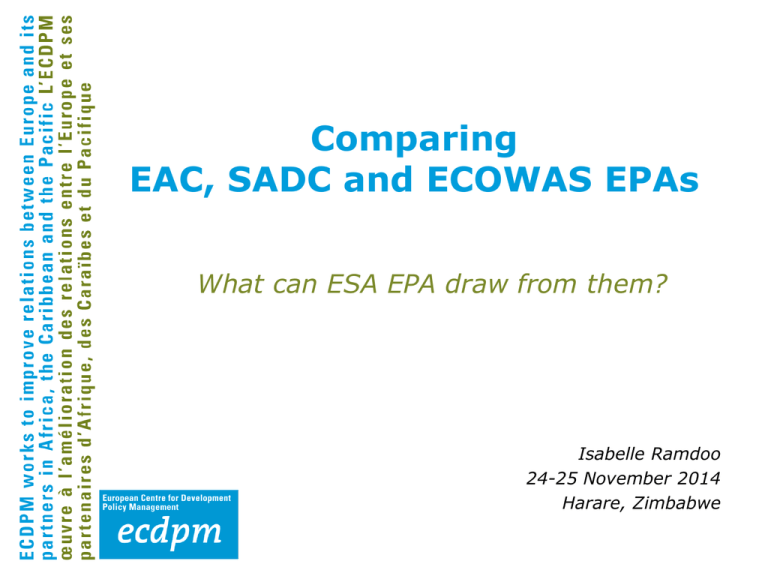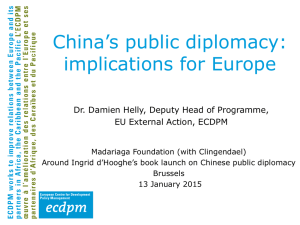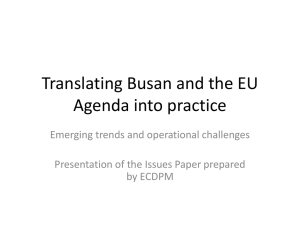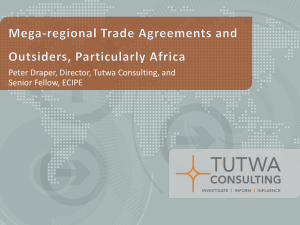publication
advertisement

Comparing EAC, SADC and ECOWAS EPAs What can ESA EPA draw from them? Isabelle Ramdoo 24-25 November 2014 Harare, Zimbabwe Structure of presentation Part I: State of play • Recently concluded EPAs: Who’s in? Who’s out? • Trade regimes with EU: where are we? Part II. Comparing EPAs: • SAT: What’s in? what’s out? • Key provisions on market access • Rules of origin Part III: EU’s trade agreements with third parties • Where are we? • Recently concluded ones: what’s important • TTIPand TTP: Game changers? ECDPM Page 2 Part I: State of play Who’s in? Who’s out? ECDPM Page 3 Who’s out? (27 ACP countries) ECDPM Page 4 b. What regimes apply to African countries? ECDPM Page 5 Part II: Comparing EPAs • ECOWAS and SADC EPA groups concluded a regional EPA in July. Market access preserved, once agreements enter into force; For the moment MAR applies for those that were under the regul; TDCA continues for SA; and GSP for Nigeria • EAC: Regional agreement concluded on 14th Oct. (after deadline). Kenya non-LDC, currently trading under GSP till agreement enters into force. Others EBA. Estimated loss: $140 million per year; Key sectors impacted fresh produce (40% destined to Europe), mainly fresh roses and cut flowers (5 – 8.5% duties); coffee (2.6% tariff). But regional unity preserved. • Cameroun: ratified goods-only EPA. No regional agreement in Central Africa • ESA: Mauritius, Seychelles, Madagascar, Zimbabwe implementing interim EPAs. No regional agreement. ECDPM are Page 6 In a Nutshell: What’s in? What’s out? What’s in? 1. On the EU side, save for South Africa, all countries have DFQF on all products: Timeframe, since 1st January 2008 for those that were covered under MAR; for others, once EPAs enter into force 2. On the African side: Trade in goods agreement + devt; Coverage: at least 75% openness over up to 25 years South Africa: 105 GI; EU: 251 GI Subsdies on agric. Exports eliminated (except in ESA) Development: PAPED Euros 6.5 billion Flexible but different RoO (on cummulation & asymetry (EAC) What’s out? Excluded: Sensitive products, including both agricultural and industrial products that are produced domestically To be negotiated: Services; Investment; IPR; and other trade related issues (RDV clause) ECDPM Page 7 Key provisions on market access 1. Tariff phase down 1. EAC EPA: to liberalize 82.6% over 25 years, as follows Exclusion: agricultural products, wines and spirits, chemicals, plastics, wood based paper, textiles and clothing, footwear, ceramic products, glassware, articles of base metal and vehicles. ECDPM Page 8 2. SADC to liberalize 80% of its trade with the EU. 2 MA lists: SACU region, namely Botswana, Lesotho, Namibia, Swaziland (BLNS) and South Africa; and Mozambique (agreed already in 2007) SACU Tariff phase down ECDPM Page 9 EU Tariff phase down for SA Geographical indication: 105 SA GI and 251 EU GI protected ECDPM Page 10 3. ECOWAS Tariff Phase down: 75% of its tariff lines, based on CET, over 20 years ECDPM Page 11 Key other provisions ECDPM Page 12 ECDPM Page 13 ECDPM Page 14 Key provisions on RoO 1. Value Tolerance ESA: 15% ex-works price (for EU and ESA) SADC: Same as ESA EAC: 15% allowed on weight on Ch 1- 24 15% ex-works price for Ch. 24 – 97 ECOWAS: 10% ex-works price for EU 15% ex-works price for ECOWAS ECDPM Page 15 2. Cummulation ECDPM Page 16 ECDPM Page 17 ECDPM Page 18 3. EAC has asymmetric RoO for on specific products: Key ones include ECDPM Page 19 ECDPM Page 20 ECDPM Page 21 Part III: FTAs with third countries ECDPM Page 22 State of play since ESA signed EPA (2009): Being implemented EU – Peru – Columbia: 2013 EU – Central America (Costa Rica, Panama, El Salvador, Guatemala, Honduras, Nicaragua, 2013 EU – South Korea: 2011 Concluded EU – Singapore: Agreement initialed in Sep. 2013 but investment negotiations concluded in November 2014 EU – Canada : 26 Sep. 2014 concluded. To be signed – 1st FTA with a G8 EU – Eastern Neighbourhood: Moldova, Armenia, Georgia: Initialled in Nov. 2013 EU – Ukraine (concluded in 2011, but signature suspended) Yet, more than 60% of EU’s trade is currently not covered by FTA. Currently been negotiated: EU – India: launched in 2007 EU – ASEAN (with 4 countries – concluded with Singapore; ongoing with Thailand, Vietnam and Malaysia) EU – Mercosur: launched in 2000; suspended in 2004; resumed in 2010 EU – Japan: Negotiations launched in April 2013 EU – US: Negotiations started in July 2013 EU – China Investment Agreement: Launched in November 2013 ECDPM Page 23 Mega-deals: a game changer? • WTO negotiations are in a deadlock; Key issues about agriculture and industrial products were not addressed in Bali and will be increasingly difficult to get concensus • Big players feel need to reshape global trading system as globalization deepens and the world become more interconnected. About 60% of global trade is made of of trade in intermediaries. Multilateral system does not seem respond rapidly enough to changes to fit a 21st century trading system • Strategic interest. Geopolitical rise of China – soon to be the leader in global trade. A way for EU and US to join forces to maintain access to key markets ECDPM Page 24 Main trading partners of large economies Fig 1: EU’s Main trading partners, 2010 Fig 2: US’s Main trading partners, 2012 Fig 3: China’s Main trading partners, 2010 ECDPM Page 25 If successful, mega trade deals are expected to have significant impacts on: • • • • Trade flows, investment direction and intensity; The structure of regional and global value chains; The regulatory dimension of trade (i.e redefining the rules of the game) Current FTAs the EU have This new generation type of agreement are expected to be about: • WTO ‘plus’ issues – i.e go deeper than what is provided for in current WTO agreements • WTO ‘extra’ issues – i.e to cover issues that are not part of WTO such as data protection, trade facilitation in supply chain management, export restrictions, consumer protection etc ECDPM Page 26 More importantly, they will : 1. not only be about tariffs, but about: a. Regulation, standards, norms b. Licensing practices c. Domestic taxes d. Investment 2. a. b. c. And not only about trade, but about Human rights; Environment; Labour rights Need to look at the future trade relationship between Europe and Africa in that broader context – the inter-connectedness between Europe and big players will have spill-over effects on EPAs (cf RDV clauses – mandate, depth, coverage etc) ECDPM Page 27 In a nutshell, we are talking about: 1.Trans-pacific partnership (TTP) – 12 countries incl. US, Japan, Canada, Australia, Singapore, Mexico, Chile, New Zealand, Brunei, Peru, Vietnam and Malaysia. 2. Transatlantic Trade and Investment Partnership (TTIP) between EU and US 1. Regional Comprehensive Economic Cooperation (RCEP), 16 countries of which 10 ASEAN countries (Brunei, Myanmar, Cambodia, Indonesia, Laos, Malaysia, Philippines, Singapore, Thailand, Vietnam); Australia, China, India, Japan, S. Korea, New Zealand. ECDPM Page 28 Key elements of the TTIP and the TTP • Tariffs (more important for US-Pacific TTP than EU-US TTIP) and potentially subsidies in agriculture • Trade in services, investment (possibly including state-investors dispute), intellectual property • Trade-related issues such as government procurement, competition policy, e-commerce, environment, state-owned enterprises (for TTP) • Regulatory and non-tariff measures such as norms, standards, testing requirements, procedures, technical regulation, food safety ECDPM Page 29 In the case of the TTIP between EU and US • Regulatory compatibility and convergence about rules will be the heart of the EU-US negotiations • It is estimated that av. tariff protection on imports in EU and US range between 2.2 – 3.3% respectively, while ad valorem tariff equivalent protection form NTMs range between 19% - 73%. • It is also estimated that up to 50% of those barriers could potentially be eliminated (most optimistic scenario) • If standards are harmonized, this means that non-parties to the agreement may be requested to meet those standard to remain competitive on the market. • Third countries (incl. African countries) may face higher compliance and trade costs if they want to maintain access to these markets (despite their existing trade regimes with EU – EPA or not!!) unless they are extented the mutual recognition agreements (under MFN??) ECDPM Page 30 Where does that leave us in ESA? Impacts: 1. On the multilateral system: • Might distract attention from WTO on key issues. • As a reaction, other large developing economies might be tempted to do same (RCEP, FTAAP) leading to competitive liberalization. • Will erode margins of preferences specially for LDCs under Hong Kong Commitments • These issues might find their way back into the WTO at some point 2. Preference erosion: • • • ECDPM TTIP (EU-US): Not much impact on EPAs or AGOA. Trade structures are not same. Issues more about regulatory convergence and non-tariff issues TTP – (US – Pacific): Challenging for AGOA. Many Asian countries key competitors; RCEP: China, India have DFQF for LDCs. Preference erosion as non-Asian LDCs will get more access to Asian markets; For the rest, will be (even more) difficult to compete in Asia Page 31 3. Rules taking As already mentioned, might have implications on the regulatory frameworks through regulatory convergences (through mutual recognition agreements) in particular on services and investment Important for ESA, because those have not been negotiated yet. Therefore key to ensure that ESA is regularly updated on what MRAs are negotiated to ensure the best deal ECDPM Page 32 Conclusion: some suggestions 1. Forging strategic responses, through a. Unilateral initiatives to calibrate domestic reforms to be prepared to meet standards. Otherwise the risk is marginalization since you will de facto become rules takers. b. Regional/ continental trade negotiations should keep pace with these evolutions and by expediting regional agenda c. In EPA Committee, these need to be regularly discussed. Use MFN clause here to the maximum extent in particular to seek the extension of MRAs on norms and standards; With US, ESA could seek a TIFA type of framework 2. Forging strategic alliances: At the WTO, through the Africa and other groups. Big players might attempt to multilateralise some of these provisions (not only on rules but also WTO plus and extra ones). Key therefore to play a leading role to ensure developing countries’ interests are preserved, while being ensuring the trading system fits the evolving global landscape. ECDPM Page 33 Thank you www.ecdpm.org www.slideshare.net/ecdpm Page 34











